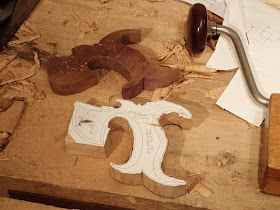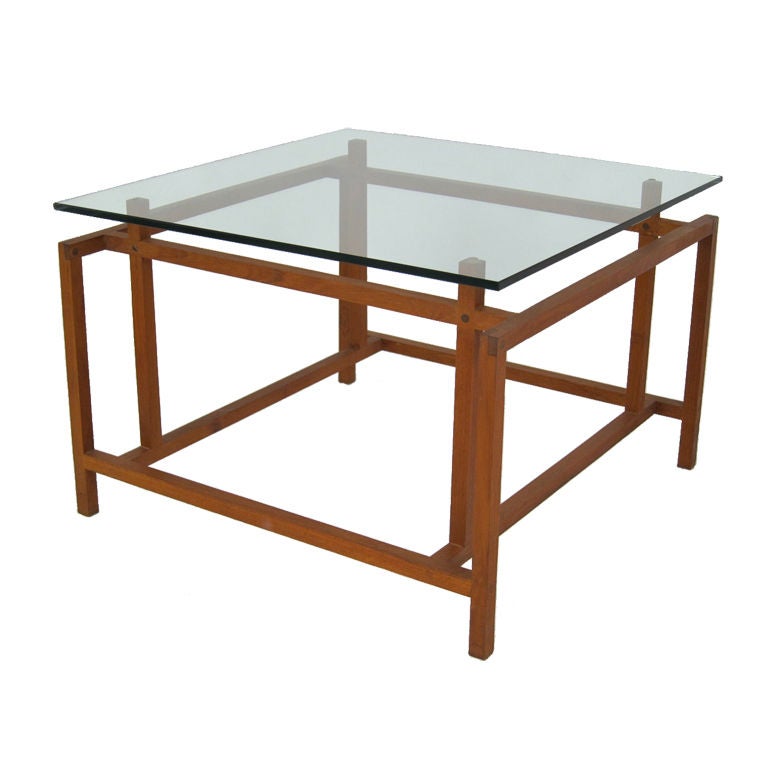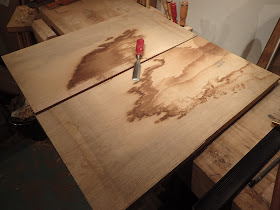I want to prep the rest of the parts for the base in my shop, but after spending half of the whole day ripping 9 out of an eventual 12 sticks out of a board, I might just run those sticks through a thickness planer, too.
A lot of people seem to me to be afraid to do their stock prep with hand tools. For the most part, I am forced to as I have none. I find that it is neither difficult nor inaccurate, and for the most part it is not slow.
When it really starts to show as a weakness for me, is when there are big parts, or lots of parts that need special cuts.
My task today was cutting 12 sticks out of an ash (Fraxinus excelsior) board. The sticks need to be about 28 inches long and one inch square or so.
The great part about doing this with a rip saw is I am given the freedom to cut this board any way I want. I decided this table's base would look best with the annular rings of each stick being more or less at a 45 degree angle to the stick. I've always called this rift-sawn, but I have also heard the term "bastard grain." The advantage is the grain looks the same on all four faces, rather than showing quarter sawn grain next to flat sawn grain. For this piece, it would look odd. I want the focus to be on the top when you are looking at this piece, so anything that sticks out or draws the eye to the base isn't going to work here.
Perhaps a photo so show what I am talking about.
 |
| Bastard! |
Tomorrow I should be able to get those last three sticks ripped out relatively quickly, then I will decide if I want to run them over to a shop with a thickness planer (likely), or square up the parts by hand (my arms hurt thinking about it).
For a bit of interest, and in line with my latest tendency toward ADD woodworking, I started another new project. Well, I also rehabbed a couple of bench planes today, but more on that later.
Jonas, the author of the blog Mulesaw, is making a couple of backsaws this trip on board his ship. He and I were chatting about the project one day, and somehow I was able to talk him into bending a piece of copper for the spine of a backsaw for me. I'm excited to see how his ship-board saws will come out. I think it would be bad manners if I didn't finish the saw. I guess I'll get started early.
I actually started to make a dovetail saw a few years back, but for some reason abandoned the project. I got as far as roughing out the shape of the handle on a piece of flatsawn walnut. I might take this opportunity to finish that saw, too.
I ordered another folded brass back from TGIAG along with a pair of sawplates punched with 14tpi teeth at 10 degrees of rake. I figured I would do a comparison of a "proper" manufactured folded brass back with Jonas' copper version. To do a proper comparison, I will make two identical saws based on the carcase saw from Smith's Key. The dovetail saw has a milled brass back from Ron Bontz.
I have a nice piece of elm that I brought back from Jonas' place in Denmark that will make a gorgeous saw handle. It will be perfect to pair this with the copper back that Jonas will provide, for a saw whose parts mostly came from Denmark. Well, Denmark and somewhere in the middle of the North Sea. The second saw will have a pear handle, I think. Let's get started on the elm:
I printed out a template from Blackburn Tools. I like this one as it looks just like the image in Smith's Key, plus there are separate files for different sizes of grips. Next I cut out an appropriate sized blank and flattened one face.
 |
| I really like working with elm. I have a bit more if I screw this one up. |
 |
| Resawing is a lot like cutting tenons. |
 |
| Kind of like Connect the Dots. |
 |
| Too bad I'm not making a book-matched panel. |
Now to start shaping. To start, I will drill out some holes. No drill press here, just bore a straight hole! As long as it is more or less close, I can straighten things and make adjustments with a rasp later.
 |
| I had a one inch Irwin pattern auger bit. |
 |
| This one left a bit of a ragged hole. |
 |
| This Ultra Smooth bit left a very nice hole. |
 |
| The blank with holes. |
 |
| Incidentally, the frame of my bowsaw is elm. |
 |
| Not quite ready yet. |






















